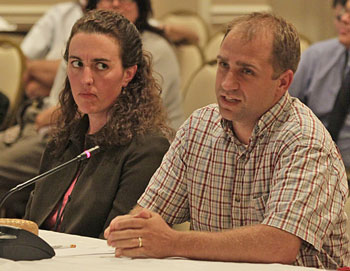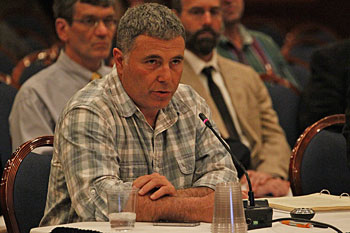How To Divide A Crumb
Fileting Yellowtail Quota
by Laurie Schreiber

Drew Minkiewicz, right, Fishermen's Survival Fund attorney. Minkiewicz said the U.S. did not do well for itself in any of the negotiations for 2013. “If this agreement were to be blown up, where would we be hurt? If this is a shared stock, we seem to be doing a lot more giving than taking. This isn’t an equal relationship.” © Photo by Sam Murfitt.
NEWPORT, R.I. – At its November meeting, the New England Fishery Management Council (NEFMC) championed its domestic groundfish and scallop fleets when it mutinied against a United States/Canada resource agreement, and approved a 1,150 metric ton limit on George Bank yellowtail flounder.
The discussion arose as part of the NEFMC’s consideration of Framework 48 to the groundfish management plan. The yellowtail allocation also fed into Framework 24 of the scallop management plan. The issues surrounding the health of the floundering George Bank yellowtail flounder stock affect both the groundfish and the scallop fisheries.
The NEFMC found itself choosing between two figures for 2013 – either 500 metric tons (mt) or 1,150 mt – for GB yellowtail’s allowable biological catch (ABC). Once it decided on which figure to use, the NEFMC would then decide on how much to allocate to the scallop fishery.
The 500-mt figure came from a recommendation by the Transboundary Management Guidance Committee (TMGC). The TMGC, established in 2000, is a government/industry committee composed of representatives from Canada and the United States. The TMGC’s purpose is to develop guidance in the form of harvest strategies, resource sharing and management processes for Canadian and U.S. management authorities for the cod, haddock and yellowtail flounder transboundary resources on Georges Bank.
According to the TMGC guidance document, the TMGC based the lowball 500-mt recommendation on the reemergence of retrospective problems with the GB yellowtail stock assessment. The figure would have resulted in a U.S. share of 215 mt, and 285 mt for Canada.
The 1,150-mt quota is based on a decision by the NEFMC’s Science and Statistical Committee (SSC) that this figure could be a backstop allowable biological catch (ABC) if measures are adopted to stop the directed yellowtail fishery and allow only a bycatch fishery. NEFMC decided that the U.S. share will be 495 mt and Canada will receive 655 mt.
The 500-mt figure would have been a 57 percent reduction from the 2012 quota of 1,150 mt, and 81 percent down from the 2011 quota of 2,650 mt.
Before the NEFMC decided on the 1,150 mt ABC, there was considerable debate over whether the U.S./Canada sharing agreement of 500 mt was acceptable.
“This is serious problem,” said Vito Giacalone, policy director at the Gloucester, Mass.-based Northeast Seafood Coalition. Giacalone proposed that the U.S. might reopen negotiations with Canada to see if the U.S. might get a bigger share.

Vito Giacalone, Northeast Seafood Coalition. The 500-mt figure would have been a 57 percent reduction from the 2012 quota of 1,150 mt, and 81 percent down from the 2011 quota of 2,650 mt. Before the NEFMC decided on the 1,150 mt ABC, there was considerable debate over whether the U.S./Canada sharing agreement of 500 mt was acceptable. Giacalone proposed that the U.S. might reopen negotiations with Canada to see if the U.S. might get a bigger share. © Photo by Sam Murfitt.
“This is basically surrendering to a policy that will potentially collapse one or both fisheries,” Giacalone said.
Drew Minkiewicz, an attorney with the Fisheries Survival Fund, told the NEFMC that, by accepting the 500 mt figure as an upper bound, “you’re accepting it’s okay, in the middle of the assessment process, to change the rules without a peer review process.”
Minkiewicz said the U.S. did not do well for itself in any of the negotiations for 2013. For example, for Eastern Georges Bank cod, the two countries agreed on a 600 mt catch, but the U.S. received a share of only 96 mt, while Canada got 504 mt.
“If this agreement were to be blown up, where would we be hurt?” Minkiewicz said. “If this is a shared stock, we seem to be doing a lot more giving than taking. This isn’t an equal relationship.”
One speaker said the figures set up both the groundfish and the scallop fisheries to fail.
“In a sense, we’re pitting brother against brother, fisherman against fisherman, in this allocation fight,” he said. “I don’t want to do that. But there’s not enough fish as a whole to make each fishery whole. The scallop fishery is in a position where we are almost set up to fail. No one wants to see that happen.”
NEFMC member David Pierce recommended that the NEFMC adopt the 1,150 mt figure. He also pointed out that part of the yellowtail allocation must also be set aside for the small-mesh whiting fishery on Georges Bank.
But NMFS chief John Bullard said the 1,150 mt figure was not based on “best available science.” He said he was encouraged by how well the groundfish fishery can avoid bycatch, and how well the scallop industry can avoid yellowtail.
Rip Cunningham, chairman of the NEFMC and co-chairman of the TMGC, said that asking for renegotiation would not be easy. “I see two outcomes,” Cunningham said. “One is that they say no to increasing the 500 metric tons. The worse-case scenario is that they decide this agreement is no longer working, because we’ve done this now four separate times.”
“We may as well kiss the sea scallop fishery goodbye,” said Pierce. New Bedford, Mass., mayor Jon Mitchell said the yellowtail situation is “highly important” to his port city’s scallop fleet. He urged the NEFMC to adopt the 1,150 mt ABC.
He said the situation could cause “hundreds or thousands of lost jobs and severe economic and social dislocation.”
NOAA general counsel Gene Martin advised the NEFMC that, just because the SSC recommended 1,150 mt as an upper bound for bycatch, it doesn’t mean the NEFMC can avoid the “immutable” legal requirement of federal fishery law, to prevent overfishing, regardless of potential negative impacts on the scallop fishery if the 500 mt figure were to be used.
If the NEFMC adopts 500 mt, said NEFMC member David Goethel, “The scallop and groundfish fishery are going to shut down. Not, ‘They might shut down.’ They are going to shut down if we adopt 500 metric tons….If the Canadians give you all the yellowtail, there’s still not enough to keep the fisheries from shutting down….So many statistical sleight of hands have been applied to this stock assessment that it’s time to admit it’s broken….At some point, it’s time to stand up and do the right thing, even if you get shot down for it. It’s time to admit there’s a problem here, and if it blows up, so what? It can’t get any worse.”
According to Saving Seafood, a non-profit corporation funded by the fishing industry, “A low catch limit on yellowtail threatens scallopers, as it is not possible to harvest scallops without some by-catch of yellowtail.”
After considerable debate, the NEFMC decided that 40 percent of the GB yellowtail allocation would go to the scallop fleet in 2013, and 16 percent in 2014 and 2015.
Originally, the NEFMC considered a plan, presented by NEFMC groundfish plan coordinator Tom Nies, that presented two approaches to the allocation, which could be applied to either ABC figure. The “fixed” approach would allocate either 8 percent or 16 percent to the scallop fishery. The advantage to the fixed approach was that it defines the allocation in advance. But the allocation would be well below expected catch.
The “90 percent of estimated catch” approach would set allocations closer to expected catch. It would mean trying to estimate what the GB yellowtail catch will be, once the scallop fleet knows what fishing activities will be like. The approach would be a closer match to planned fishing activity and has an automatic adjustment built in. But, Nies said, it’s complicated and has mixed prediction performance.
The groundfish fishery is facing a major reduction in revenue in the next fishing year, which begins on May 1, 2103.
“We’re expecting a decline of maybe 50 percent less, maybe 60 percent less than 2011, of gross groundfish revenues in 2013,” Nies said. For the scallop fishery, the impacts are “perhaps a little more certain,” he said. “This fishery is far more predictable. People have an idea of how much they can catch.”
Groundfisherman Jim Odlin, president of Atlantic Trawlers Fishing in Portland, said the groundfishery, through the sector management system, has been doing its part to manage bycatch. “Haddock is our bread and butter, and yellowtail is important to us in order to access haddock,” Odlin said. “This year, we only caught 5 percent of our yellowtail allocation.”
Odlin said he supported a fixed percentage of yellowtail for the scallop fleet, starting with 40 percent in 2013, but then ratcheting down to 16 percent. He also proposed that the scallop fleet should have a mechanism, perhaps trading, to adjust.
But Maggie Raymond, executive director of Associated Fisheries of Maine in South Berwick, said that 40 percent is too high.
“We can’t throw the groundfish fleet under the bus to help other fisheries,” Raymond said. “Give them a fixed percentage, and I think they’ll figure out how to live with it. We do that. We don’t have any other choice.”
“There’s really not enough to allocate,” said Fisheries Survival Fund attorney David Frulla. “The decisions become about equitable access to the fishing grounds. The scallop fleet has had access out there for as long as the groundfish fleet has. It’s a shame the guys in New Bedford are having these difficulties. It’s not a fight between scallopers and the groundfishermen. It’s the crappy numbers. One of the reasons for the disaster declaration was because there was no Georges Bank yellowtail. The council shouldn’t pretend that, if you cut a crumb in eighths, there will still be something valuable….It’s a terrible decision to be made, largely due to the bad science.”
Chris Brown, president of the Rhode Island Commercial Fishermen’s Association, said that, as a Southern New England fishermen, he was left wondering “how much of this will slide down and end up on my plate.” Brown said he expected that the GB yellowtail quota would be caught early, and the scallopers would then steam to Southern New England.
In the end, the NEFMC decided on the 40 percent allocation for the scallop fleet in 2013, reduced to 16 percent in 2014 and 2015. The percentage would be applied to the 1,150 mt figure, rather than the 500 mt figure.
“This has gone from the sublime to the bizarre,” said NEFMC member David Preble.
“Nothing clarifies the mind about bycatch reduction like being given a number that you can’t live with,” said NEFMC member David Goethel.
